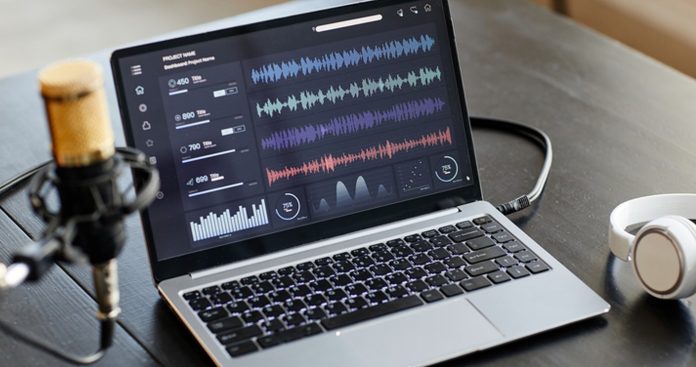If you use your laptop to attend online classes or meetings, background noise can significantly impair your communication ability. Maybe there is distant chatter near you. Or perhaps you could hear the low humming of construction work from a distance. Whatever the reason, background noise can occur for various reasons and requires a conscious effort to eliminate.
Reducing background noise in a laptop microphone requires treating your recording area as a professional studio. Take the time to prepare your environment and make necessary adjustments to remove potential disruptors. Are people talking nearby? Maybe the best solution is to relocate yourself to a quieter space instead. Pre-emptively eliminating background noise will improve your ability to produce recordings with crisp audio.
In addition, the best laptops come with sophisticated microphone technology that enables you to reduce background noise. You will need to adjust the audio settings to unleash the microphone’s full potential. Here are some ideas to improve the sound quality of your internal microphone:
1. Adjust the internal microphone volume
Finding the appropriate volume level for your internal microphone will help prevent buzzing and other unwanted noises. Type “microphone” into the Windows start menu and click on the Levels tab. From here, you can adjust the volume to suit your laptop and environment.
If you still experience background noise and fuzziness, you can try uninstalling the microphone device and restarting your laptop. After restarting, the system will automatically reload the microphone device and include any updates it may have missed. Laptops with built-in array microphones like the ASUS ZenBook Pro Duo also do an excellent job of capturing your voice. It uses sophisticated amplifier technology to deliver finely-tuned audio with no distortions.
2. Adjust noise suppression settings
Microsoft makes it easy to control noise suppression settings in the integrated microphone options. You can find these settings by typing “hardware and sound” in the start menu, then clicking the sound category. Under the recording tab, you can see the properties of the microphones connected to your laptop.
Try lowering the Microphone Boost option to decrease the amount of noise picked up by the microphone. You can also try drastically reducing the Microphone Boost to barely pick up any audio. Then, increase the microphone volume to the maximum level so people can still hear you. Playing with the settings in this section is a great way to enhance the quality of your laptop microphone.
3. Choose a room with good acoustics
Your physical location significantly impacts the background noise picked up by a laptop microphone. Avoid choosing large rooms as the extra space distorts the audio quality. Rooms with large windows and high ceilings also create a reverb effect, which will produce unnecessary background noise.
If forced to record in a room with a window, use heavy curtains or blankets to help muffle the sound. The ideal recording space in your home is a small room with no windows and lots of furniture to absorb sound. Laptops like the ASUS ROG Flow X13 come with two-way noise-cancelling software powered by artificial intelligence. The technology does an excellent job of filtering unwanted noises.
4. Move away from sources of sound
Neighbors, nearby construction work, and running appliances are a few examples of background noises that can come from your home. If possible, try and move to a section of your home least exposed to outside noise. Covering your windows with heavy drapes is a highly effective technique to eliminate street noise from coming into your house.
Sometimes, your laptop’s cooling system might activate while you’re recording. If this happens, move to a position where the laptop can receive more air so that the fans turn off.
5. Use audio editing software
If you’re forced to record in a noisy environment, you can still salvage the recording by editing the audio. Using free programs like Filmora, Audacity, and Lightworks, you can eliminate background voice and enhance voices from your audio recordings. In Audacity, you can use the “noise reduction” effect to optimize the sound quality. Many editing programs have options that help you enhance voices in your recordings.
6. Keep your drivers updated
One of the best ways to improve sound quality from your internal microphone is checking for driver updates. You can use the Windows device manager or download the sound drivers directly from the manufacturer’s website. If you notice your microphone cutting in and out, it’s worth checking if you have the latest drivers installed. Part of reducing background noise in a laptop microphone is being familiar with your audio drivers.
7. Modify your microphone’s sensitivity
Playing with your mic settings will help you find the ideal setup for your internal microphone. Adjusting microphone sensitivity will prevent your voice from sounding too loud. It also reduces how much noise is picked up from the background.
Different microphones have different sensitivities, so you’ll need to find the settings best suited for your laptop. When adjusting the settings, keep in mind microphones with high sensitivity don’t need as much gain. Turning down the gain on a high-sensitivity laptop can help reduce background noise during video calls or recordings.
8. Improve the audio quality of your recording area
Creating a pseudo-recording studio in your home can prevent your microphone from picking up any unwanted background noise. Try recording in a room with carpet as the material prevents sound from bouncing off walls or windows. You can also add rugs to your recording room to enhance the sound dampening effect.
Remember to remove any fans or other noisy electronic devices from your room while recording. If the ambient noise in your home is thunderous, you can cover your walls in quilts and thick blankets. Doing so creates a sterile recording environment.


































